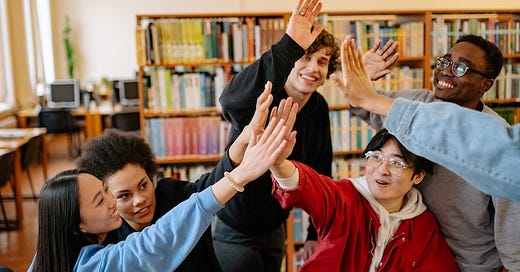[Day 5] After the Honeymoon Phase: Maintaining Your Student-Centered Practices ~ Building a Community Takes Trust
Positive classroom culture starts with creating a true community and that can't happen without trust.
It’s day 5 of our 31 day series but I want to preface this email with a disclaimer.
If reading or thinking about work on a Saturday is violating a boundary— respect yourself, and mark this email as unread and come back to it tomorrow or Monday!
Okay now that we got that out of the way, back to our regularly scheduled program, let me give you this student-centered work!
Building strong classroom culture requires a commitment to community not control. As student-centered practitioners our goal should always creating space for student autonomy and agency and if we don’t trust our students enough to make their own choice that will never happen.
In a classroom committed to control, you’ll see rigid seating arrangements, teachers constantly managing behavior, and students hesitant to speak or share ideas freely. The focus is on compliance, and learning often feels like a set of tasks to complete rather than an opportunity to grow.
On the other hand, a classroom built on trust feels entirely different. Students are active participants in their learning, they ask questions, collaborate with peers, and take ownership of their work. The teacher’s role shifts from enforcer to facilitator, and the environment feels safe, supportive, and engaging.
Creating this kind of community starts with trust—between teachers and students, and among students themselves.
Here’s how to build it:
1. Consistency: Students need to know that you’ll follow through on what you say. Set clear expectations, but also be consistent in how you respond. Consistency shows students that they can rely on you.
2. Listen More Than You Talk: Remember student voice is the name of the game and trust grows when students feel heard. Actively listen to their concerns, feedback, and ideas. But it can’t stop there, you also have to validate their voices by responding thoughtfully and incorporating their suggestions where possible.
3. Model Vulnerability: Share your own experiences, challenges, and even mistakes. When students see you as human, they’re more likely to trust you and feel comfortable opening up.
4. Create Community Among Students: Encourage collaboration and group activities that promote teamwork. Give students opportunities to rely on one another, which builds trust within the class as a whole.
Trust transforms classrooms from places of control to communities where students feel empowered to learn, grow, and connect. It doesn’t happen overnight, but with consistent effort, you’ll see the difference trust makes in the atmosphere and overall success of your students.
I’ll be working this week to build trust in my classroom through my students first group projects this year, I’m nervous but this will serve as an opportunity for students to work together, take ownership over their learning, and make mistakes that will serve to support my understanding of how to serve them better.
This student-centered work is trial and error sometimes but worth it in the long run! Let’s build communities rooted in trust and watch our students thrive.
Talk tomorrow!



